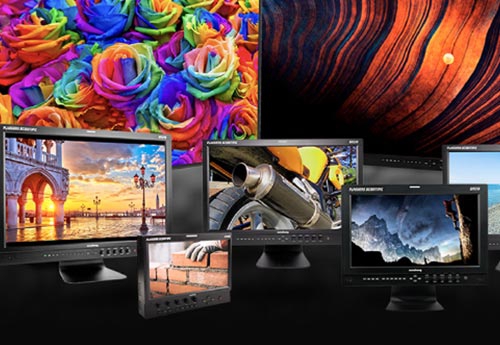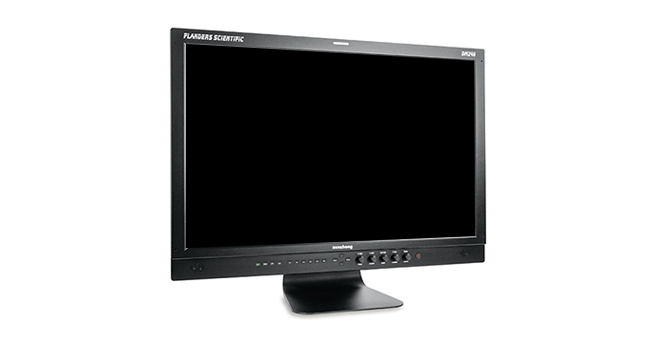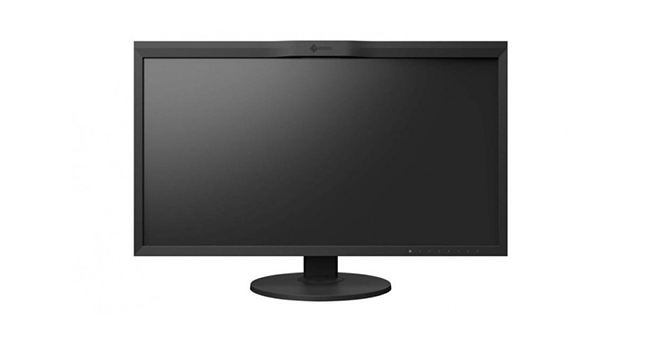
The Ultimate Guide to Color Grading Monitors (2021)
Stig Olsen
A color grading monitor is the heart of any color grading suite, and there are many options on the market. A true reference monitor with precise color reproduction is a big investment, and we will guide you through the most common models used in post-production facilities around the world.
Professional color grading monitors let you evaluate the image with extreme accuracy, which is required when you have to make guarantees about the delivery. They are reliable over time and ideally equipped with useful features that make your job easier, such as advanced real-time scopes, split-screen viewing, anamorphic de-squeeze, and pixel zoom functions.
1. Flanders Scientific DM240 (24")

The most acclaimed color grading monitor in the professional range is the 24-inch DM240 ($4295) from Flanders Scientific, Inc. (FSI). FSI is trusted by the colorist community for the quality of their products and are known for their excellent service and support.
The 1920x1200 (HD) resolution display comes with a specialized toolset tailored for colorists. It includes a variety of video and audio analysis tools like Real-Time Customizable Multi-Color Waveform, Parade, Vector, Histogram, and multi-channel audio. It also supports advanced features such as ScopeStream, Image Flip, Second Screen Output, and many other features that can’t be found in more affordable models. In addition, it has a ton of on-set features like LiveGrade integration, zero delay mode, and DIT Look LUT functionality, which makes it shine on set as well as in the suite.
The DM240 comes pre-calibrated from the factory and FSI offers free lifetime re-calibration for customers that would like to send the units to one of their service departments. It also supports AutoCal, an internal auto-calibration solution that lets you perform a fast and accurate calibration. Simply plug a supported probe directly into the monitor and the calibration is performed in one simple, fast, and unified operation without the need of any software. The probes supported for this solution are the affordable x-Rite i1d3 OEM Probe, Colorimetry Research CR100, Klein Instruments K10A, and Minolta CA310. The more affordable x-Rite is accurate enough for professional use, but the others will provide extremely accurate results.
This is definitely one of the most dependable, accurate, and trustworthy reference monitors available on the market for 1920x1080 delivery.
2. Eizo CG319X (31")

An alternative to the DM240 is the 31-inch CG319X ($5739) from Eizo’s CG-professional line. This is a popular model that is widely used by professional colorists working in smaller studios, and the screen is a bit larger. It displays 4096x2160, which is ideal when delivering projects in 4K and provides superb color accuracy.
Eizo is generally known to create great monitors, but you need to be aware of their limitations. The built-in calibration capabilities can offer users an affordable way to get you started, but a 3rd party calibration solution like, ColourSpace or Calman, would be needed for more accurate calibrations.
The feature set is limited and popular analysis tools available on professional monitors from FSI and Sony are missing. It has basic functions, such as safe area and aspects markers for checking how text, graphics, and compositions of a scene will appear in other viewing environments, and a useful zoom function that lets you confirm small details and check focus accuracy.
While most professional monitors have SDI connections, it's worth nothing that the Eizo monitors have HDMI only, so make sure your output device supports HDMI.
The CG319X is a reliable color-accurate 4K monitor that is widely used in professional environments, but you need to be aware of the limitations and weigh up the pros and cons.
2. Sony BVM- E251 (24")

Sony has always been a significant player in the color grading monitor market, and their only alternative in this segment is the 24-inch BVM- E251 ($10,595). They have always offered highly accurate displays, consistency, and for many facilities a certain amount of brand awareness that can make some clients more comfortable.
The monitor comes with limited external calibration possibilities and claims that 3D calibration is not needed. This is a debated topic, but most reports show they rarely drift and small adjustments to white and back points are all that is required.
Many of the high-end color grading facilities already own one of the top of the line mastering monitors from Sony, and it can make sense to add this to their arsenal as it will offer a better perceptional match to the other models.
While it offers a very limited feature set, the viewing angle for picture evaluation is exceptionally good and allows several people to sit around the monitor and evaluate the image at the same time.
PROFESSIONAL HDR MONITORS

The color grading monitors mentioned above are all capable of displaying standard dynamic range images, which is the current standard for video and cinema monitors. If the plan is to deliver work in HDR, you are looking at a significantly higher price range.
For real HDR, you will have to invest in a monitor, like FSI’s flagship XM310K ($25,000) with 3000 nits. Eizo’s CG3146 ($30,000), and Sony’s new BVM-X310 ($30,000) are limited to 1000 nits. The most popular model in the high-end facilities today is undoubtedly Sony’s discontinued model X300, however, the FSI XM310K is a strong candidate to become the new number one in those facilities.
OTHER ALTERNATIVES?
To be fair, there are other professional reference monitors and brands that could be on this list, but we have narrowed it down to the most common ones.
There are definitely colorists successfully working on smaller 17-inch color grading monitors in the professional range and 8-bits production monitors, but we have deliberately excluded those from the list.
Many have also great success working on Asus Pro Art, LG CX 55” and other consumer alternatives. Just bear in mind that the signal processing on those screens is not necessarily at the same level as on professional monitors, functions are missing and they often have underlying issues such as noise, banding, poor screen uniformity, etc. If you go this route, be prepared to participate in the panel lottery.
As the budget and scale of distribution for a project go up, there could be financial risks involved and certain requirements for the delivery, so you need to rely on your reference monitor.
Good luck with your choice!
By Stig Olsen
Thanks to @Jason Myres for contributing to this article
This post might include affiliate agreements, for full information click here.
-
 3
3
-
 1
1
Recommended Comments
Join the conversation
You can post now and register later. If you have an account, sign in now to post with your account.
Note: Your post will require moderator approval before it will be visible.